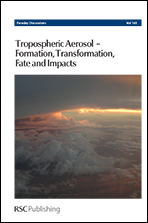The magnitude and sources of uncertainty in global aerosol
Abstract
Aerosol radiative forcing over the industrial period has remained the largest forcing uncertainty through all IPCC assessments since 1996. Despite the importance of this uncertainty for our understanding of past and future climate change, very little attention is given to the problem of uncertainty reduction in its own right, mainly because most uncertainty analysis approaches are not appropriate to computationally expensive global models. Here we show how a comprehensive understanding of global aerosol model parametric uncertainty can be obtained by using emulators. The approach enables a Monte Carlo sampling of the model uncertainty space based on a manageable number of simulations. This allows full probability density functions of model outputs to be generated from which the uncertainty and its causes can be diagnosed using variance decomposition. We apply this approach to global concentrations of particles larger than 3 and 50 nm diameter (N3 and N50) to produce a ranked list of twenty-eight processes and emissions that control the uncertainty. The results show that the uncertainty in N50 is much more strongly affected by emissions and processes that control the availability of gas phase H2SO4 than by uncertainties in the nucleation rate itself, which cause generally less than 10% uncertainty in N50 in July. Secondary organic aerosol production is assumed to be very uncertain (5–360 Tg a−1 for biogenic emissions) but the effect on global N3 uncertainty is <3% except in a few hotspots, and generally <2% for N50. A complete understanding of the model uncertainty combined with global observations can be used to determine plausible and implausible parts of parameter space as well as to identify model structural weaknesses. In this direction, a preliminary comparison of the model ensemble with observations at Hyytiala, Finland, suggests that an organic-mediated boundary layer nucleation mechanism would help to optimise the behaviour of the model.
- This article is part of the themed collection: Tropospheric Aerosol – Formation, Transformation and Impacts

 Please wait while we load your content...
Please wait while we load your content...